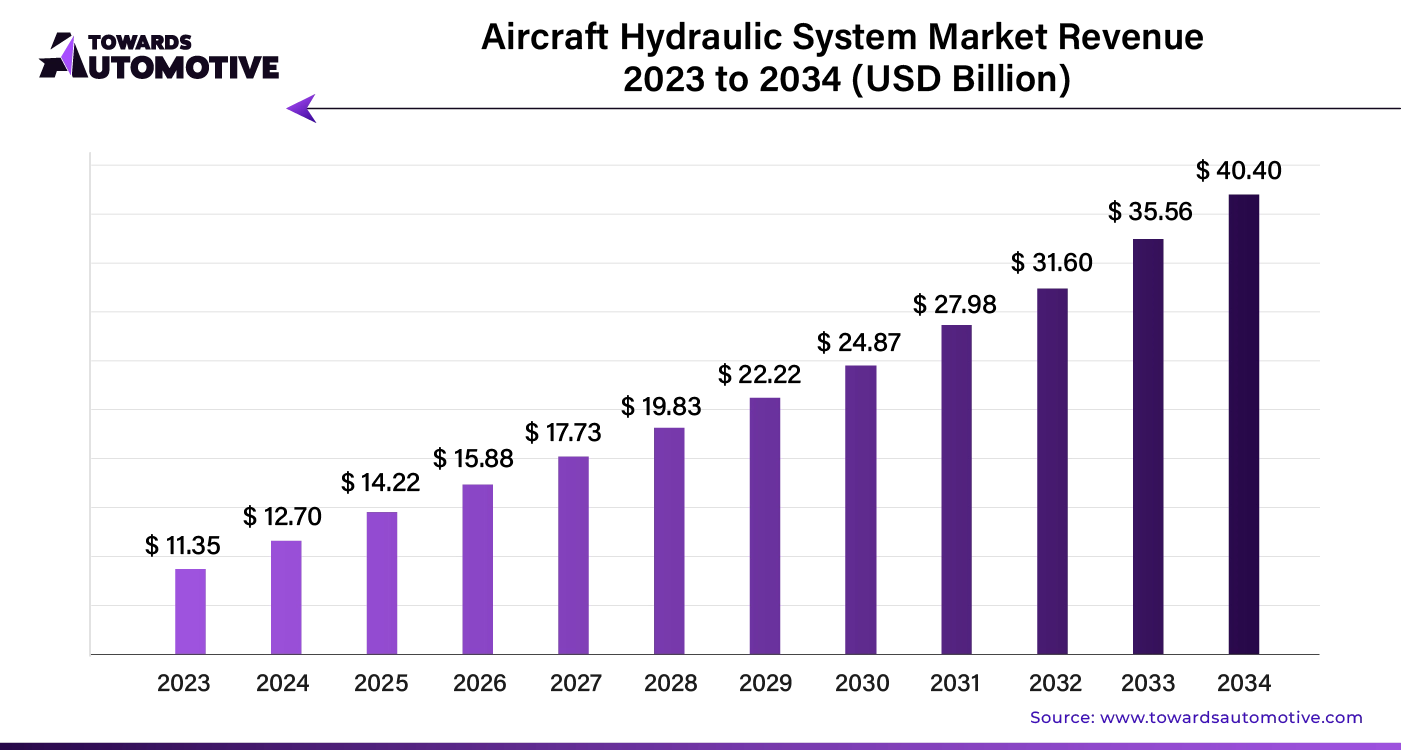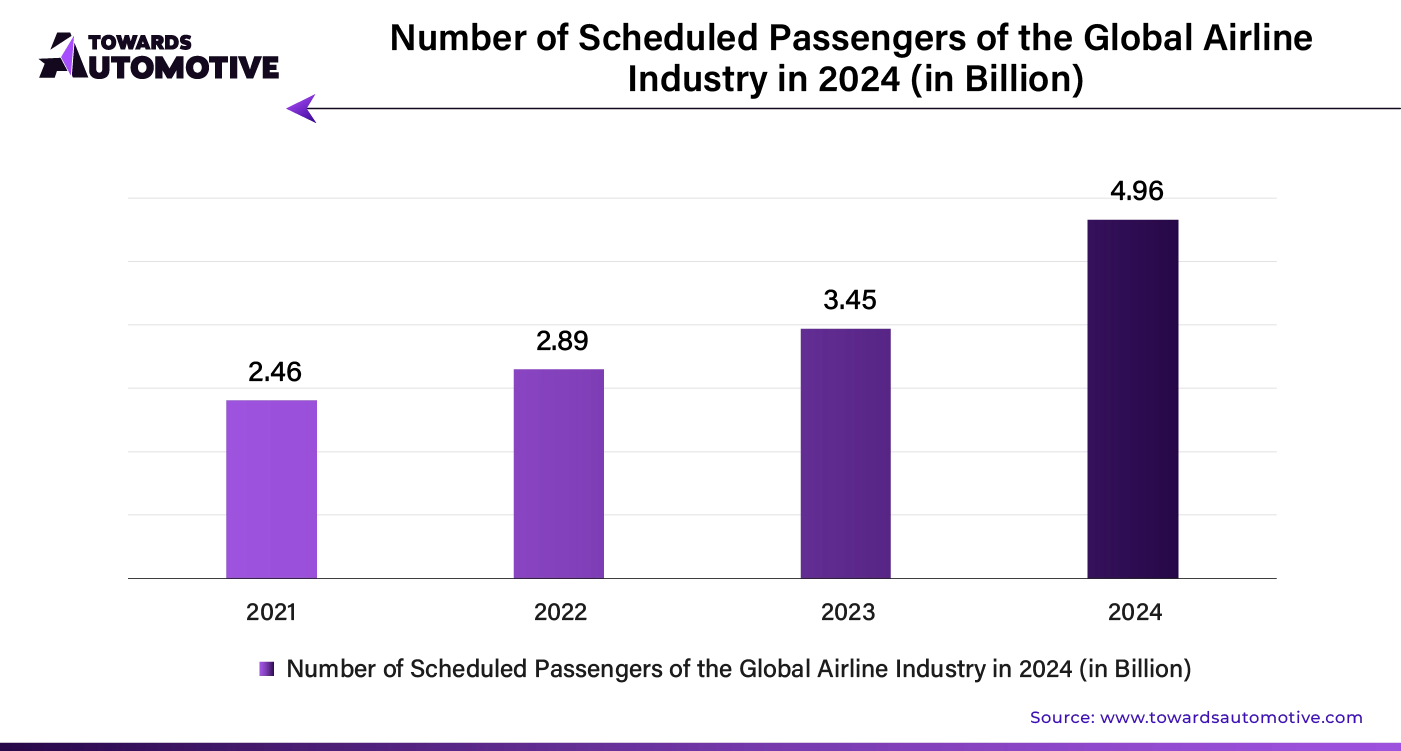April 2025
The global aircraft hydraulic system market size is calculated at USD 12.70 billion in 2024 and is expected to be worth USD 40.40 billion by 2034, expanding at a CAGR of 11.90% from 2023 to 2034.

Unlock Infinite Advantages: Subscribe to Annual Membership
The demand for aircraft hydraulic systems is driven by the need for highly reliable systems, higher power-to-weight ratios, and reduced cooling costs due to the low heat generated. However, the market faces challenges from high maintenance costs and the significant weight of these systems.
The aviation industry’s shift toward more electric aircraft is reshaping hydraulic systems. Electrically driven components in modern designs affect how these systems function and are structured. The automotive market valued at USD 4,070.19 billion in 2023, is experiencing growth and is projected to surpass USD 6,678.28 billion by 2032, with a significant CAGR of over 5.66%.
Strict safety and performance regulations push for continuous innovation in hydraulic system designs. Additionally, the global expansion of the aviation sector, fueled by the demand for new aircraft and advanced hydraulic systems, is boosting market growth.
Aircraft manufacturers and operators continually seek advanced technology to enhance performance, focusing on fuel efficiency and environmental sustainability. Hydraulic systems play a crucial role in achieving these goals, offering reliable and lightweight solutions for essential aircraft functions, thereby contributing to increased fuel efficiency and driving market growth.
In military aviation, hydraulic systems are vital for various critical functions. Global defense modernization efforts demand advanced hydraulic technologies to enhance military aircraft capabilities.
Strict safety standards in aviation require hydraulic systems to meet rigorous regulations, emphasizing their importance for aircraft safety. The ongoing evolution of safety regulations and the emphasis on reliability are fueling the demand for advanced aircraft hydraulic systems.
High maintenance and inspection costs for hydraulic systems impact airlines and aircraft operators, driving them to seek alternatives with lower maintenance needs. This shift affects the sales of traditional aircraft hydraulic systems.
Environmental concerns about hydraulic fluids also pose challenges. The industry’s focus on sustainability highlights the environmental risks associated with hydraulic fluid leaks and spills, leading to a preference for eco-friendly solutions and restricting the adoption of conventional hydraulic systems.
Moreover, rapid technological advancements in the aviation sector create pressure on manufacturers and operators to adopt the latest innovations, which can limit the market growth for traditional aircraft hydraulic systems.

The integration of Artificial Intelligence (AI) into aircraft hydraulic systems is set to significantly boost market growth. AI enhances predictive maintenance by analyzing data from hydraulic components to forecast potential failures before they occur. This proactive approach reduces downtime and maintenance costs, directly benefiting airlines by increasing operational efficiency and safety.
AI also optimizes hydraulic system performance through real-time monitoring and adjustments. By leveraging machine learning algorithms, AI systems can dynamically adapt to varying operational conditions, ensuring that hydraulic systems function at peak efficiency. This optimization leads to improved fuel efficiency and reduced environmental impact.
Moreover, AI-driven diagnostics streamline troubleshooting processes. Advanced algorithms quickly identify issues, enabling faster repairs and minimizing operational disruptions. The adoption of AI technology not only enhances system reliability but also drives innovation in hydraulic design, fostering new market opportunities.
The aircraft hydraulic system market relies on a well-coordinated supply chain to ensure the seamless operation of hydraulic components. Initially, raw materials such as aluminum, titanium, and hydraulic fluids are sourced from trusted suppliers. These materials are then delivered to manufacturers who assemble and test hydraulic systems and components.
Manufacturers prioritize quality control, adhering to rigorous industry standards and regulations. Once tested, the components are shipped to original equipment manufacturers (OEMs) and maintenance, repair, and overhaul (MRO) providers. OEMs integrate these parts into aircraft during production, while MRO providers use them for servicing and repairs.
Timely and efficient logistics are crucial, with suppliers, manufacturers, and end-users coordinating to minimize downtime and reduce costs. Distribution networks ensure that components reach their destinations quickly and reliably. Additionally, real-time tracking systems provide visibility into the supply chain, allowing for proactive management of potential disruptions.
By maintaining robust supplier relationships and leveraging advanced technology, the aircraft hydraulic system market can achieve optimal performance and reliability. Effective supply chain management ensures that hydraulic systems function correctly, supporting the safety and efficiency of aircraft operations.
The Aircraft Hydraulic System market thrives due to several core components and contributions from major industry players. The primary components include hydraulic pumps, actuators, reservoirs, and control valves, each essential for the system's operation. Hydraulic pumps, provided by companies like Parker Hannifin and Eaton Corporation, generate the necessary pressure for hydraulic power. Actuators, from manufacturers such as Moog Inc. and Honeywell International, convert hydraulic pressure into mechanical movement, crucial for aircraft control surfaces. Reservoirs and control valves, supplied by companies like Bosch Rexroth and Safran, store hydraulic fluid and manage its flow, ensuring system efficiency and reliability.
Major players in the market enhance the ecosystem by continually innovating and expanding their product offerings. For instance, Collins Aerospace develops advanced hydraulic systems with improved safety and efficiency features. Additionally, Rockwell Collins and Zodiac Aerospace contribute with cutting-edge technologies that support next-generation aircraft designs. Through their contributions, these companies ensure the development of more reliable, efficient, and safe hydraulic systems for the aviation industry.
Reservoirs Drive Market Leadership with Significant Growth
In the aircraft hydraulic systems market, reservoirs stand out as the leading product category. They are anticipated to grow at a strong Compound Annual Growth Rate (CAGR) of approximately 11.5% through 2034. Reservoirs are essential for ensuring a steady hydraulic fluid flow and optimizing the performance of hydraulic components. This critical role helps minimize maintenance costs and operational downtime, making reservoirs a valuable investment for companies seeking durable hydraulic solutions.
Vegetable-Based Fluids Experience Notable Expansion
The vegetable-based segment is on a notable growth trajectory, expected to increase at a CAGR of around 11.3% from 2024 to 2034. This segment's growth is fueled by its effective integration with existing systems and the rising preference for environmentally friendly alternatives. Vegetable-based hydraulic fluids are gaining traction due to their biodegradability and compliance with safety and regulatory standards. As environmental concerns heighten, these fluids are becoming a favored choice in the aircraft hydraulic systems market.
In summary, while reservoirs continue to dominate the market due to their crucial role and robust growth, vegetable-based fluids are seeing accelerated expansion, driven by their environmental benefits and regulatory adherence.
The aircraft hydraulic systems market is witnessing significant growth across various regions, with Asia Pacific emerging as a key player due to its resilient manufacturers and rapid technological advancements.
Asia Pacific’s Rapid Expansion
In Asia Pacific, South Korea is experiencing remarkable growth in its aircraft hydraulic systems sector. Expected to reach approximately $2.4 billion by 2034, South Korea's market is growing at a strong CAGR of 13.8%. This growth is fueled by the country’s focus on advanced technology, military modernization, and investments in aerospace research and development. South Korea's emphasis on training skilled aerospace engineers further supports innovation in hydraulic systems.
Japan’s Growth Driven by Safety Standards
Japan's aircraft hydraulic system industry is set to expand at a CAGR of 13.0%, reaching around $4.1 billion by 2034. Japan is leveraging its commitment to stringent safety standards and regulatory compliance to drive growth. The integration of hydraulic systems into Japan’s commercial and defense aerospace sectors reflects a shift towards modernization and fuel efficiency, supported by ongoing aerospace R&D.
China’s Market Expansion
China's aircraft hydraulic systems market is forecasted to grow at a CAGR of 12.8%, achieving about $6.0 billion by 2034. The growth is driven by China's strategic investments in aerospace development and government incentives for innovation. The expanding middle class and increased air travel demand are also contributing to the market’s expansion, fostering opportunities for international collaborations.
United Kingdom’s Focus on Sustainability
The United Kingdom is expected to see its aircraft hydraulic systems market grow at a CAGR of 12.8%, reaching approximately $1.7 billion by 2034. The UK's emphasis on sustainable aviation solutions is driving demand for hydraulic systems that enhance fuel efficiency and reduce carbon emissions. Its strong aerospace sector supports the development and export of advanced hydraulic systems.
United States’ Market Dynamics
In the United States, the aircraft hydraulic systems market is projected to grow at a CAGR of 12.3%, reaching around $7.0 billion by 2034. This growth is driven by the modernization of outdated aircraft fleets and the adoption of smart, connected hydraulic systems. The focus on operational efficiency and predictive maintenance is also playing a crucial role in shaping the market.
The aircraft hydraulic system industry is highly competitive, with numerous manufacturers vying for market share through technological advancements, product innovation, and strategic collaborations. Leading companies like United Technologies Corporation, Parker Hannifin Corporation, and Safran play key roles in shaping market dynamics. Eaton Corporation, Liebherr Group, and Honeywell International Inc. each contribute unique strengths to the market. Noteworthy vendors such as Triumph Group and Moog Inc. are also recognized for their innovative solutions.
By Product
By Fluid Type
By Wing Type
By End User
By Region
April 2025
April 2025
April 2025
April 2025
Dr. Arjun Patel is a distinguished expert in the automotive industry, holding advanced degrees in Automotive Engineering and Mechanical Engineering. His expertise spans automotive market dynamics, technological advancements, and sustainable practices. Dr. Patel excels in conducting in depth research and analysis on market trends, consumer preferences, and the economic implications within the automotive sector. He is renowned for his insightful publications on topics such as electric vehicles, autonomous driving technologies, and the evolution of sustainable transportation solutions. Dr. Patels research contributions have significantly advanced understanding in the field, earning him recognition as a leading authority in automotive research and analysis.
We offer automotive expertise for market projections and customizable research, adaptable to diverse strategic approaches.
Contact Us